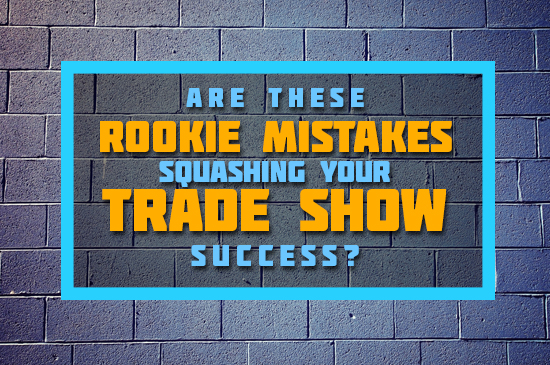Exhibiting at a trade show is a big investment of time, energy and money. Long days on the exhibition floor can be gruelling, especially if you are not getting the results that you want.
Getting the most out of your trade show investment takes careful planning ahead. In this article we look at what exhibitors can do before the show to make sure they get the best results and how to avoid some common pitfalls.

Trade shows are a great opportunity to showcase products and services to your audience. Attendees at trade shows have pre-selected themselves as interested in your industry and the great majority of them have buying power. In short, you have a concentrated and captive audience of potential customers with money to spend.
Statistics show that trade shows are highly effective. 77% of decision makers report finding at least one new supplier at the last show they attended. However, this impressive statistic doesn’t tell us anything about which exhibitors are successful.
The fact is that a busy trade show floor is a zoo and you are going head-to-head with your closest competitors. How do you make sure that you stand out from the crowd and attract your customers?
Most of the real work in establishing a successful show happens in your pre-show preparation. Here are some rookie errors in preparing for your show and how to avoid them.
1. The Wrong WHY
Why are you exhibiting at this trade show? Do you want to make sales, develop your brand, build your customer base or meet new buyers? Many newcomers to trade shows have unrealistic dreams of selling truck-loads of products to enthusiastic customers. For the most part this is not what happens. People attend shows to browse not buy. The majority of the buying will happen after the show.
In most cases the primary reason for exhibiting at a trade show is to gather qualified leads. You are at the show to identify and connect with potential customers for future follow-up.
2. Focusing on Quantity not Quality
A mistake is to focus on the quantity of leads you get rather than quality. It is relatively easy to get people to give you their business card if you tempt them with the opportunity to win a prize. However, these are not qualified leads and you have no way of knowing if they really are potential customers.
A qualified lead is someone you have spoken with for long enough to know that they actually need or are interested in your product or service. Two to three qualified leads in an hour are worth 50 business cards from people you know nothing about.
3. Preparing for the Big Sell
Standing on a trade show floor and trying to sell to random passers by is no fun. The days of being a salesman are, thankfully, over. Business success is about cultivating relationships.
Relationship building begins before the show. Do your research ahead of time to create a short-list of your individuals or companies that you want to do business with. This is particularly important if you are selling to other businesses.
Create a list of 30-40 companies who you really want to connect with and call them ahead of the show to make a personal connection. Let them know you will be there and you would really appreciate them coming to your booth.
Extend an invitation for connection and collaboration, rather than as sales pitch for your product. Most people will respond positively if you ask them to visit your booth to give you feedback on a new product line.
4. Give-aways for Everyone
It’s tempting to give away lots of goodies at your booth. However, this can be expensive and doesn’t necessarily get you the results you want. Instead, make sure you value and reward your top prospects, the 30-40 people you spoke with pre-show and invited personally to your booth.
When your top prospects visit your booth lavish them with your time and attention. Listen to their feedback and engage them in how to improve your product. Thank them with a great gift and make sure you have all their details so you can follow-up up with them after the show.
5. Ignoring Social Media
Most established trade shows have a large social media presence, often with tens of thousands of followers, likes and fans. The trade show is an opportunity to reach this massive audience, even if your own following is relatively modest.
Set up social media monitoring so that you can easily follow the activity of the trade show for at least a month in advance. Get the Twitter event handle and hashtag set up on your systems so that you can see every time the event is mentioned.
Track the conversation to find out the hot topics, connect with potential customers and find out who the major influencers are. A favourable tweet, blog post or review from a someone who is highly connected could make all the difference.
Be generous with your own social media efforts in promoting the event and don’t just talk about yourself. Look for allies and influencers and share their content. This is a great way to make friends and connections before the show.
In Conclusion
Preparing for a trade show can be overwhelming, especially when you are a newcomer. The key to a successful show is doing the thinking and planning ahead of time to make sure that you are set-up for success.
Focus your preparation on relationship building not selling. If you leave the show having established 10-15 great relationships you are in a stronger position than having collected hundreds of business cards.
While we have focused here on pre-show preparation, don’t forget the most important factor of all: your follow up! Following up after the show is the only thing that will make all your hard work worth while. So make sure you plan your follow-up time too.





